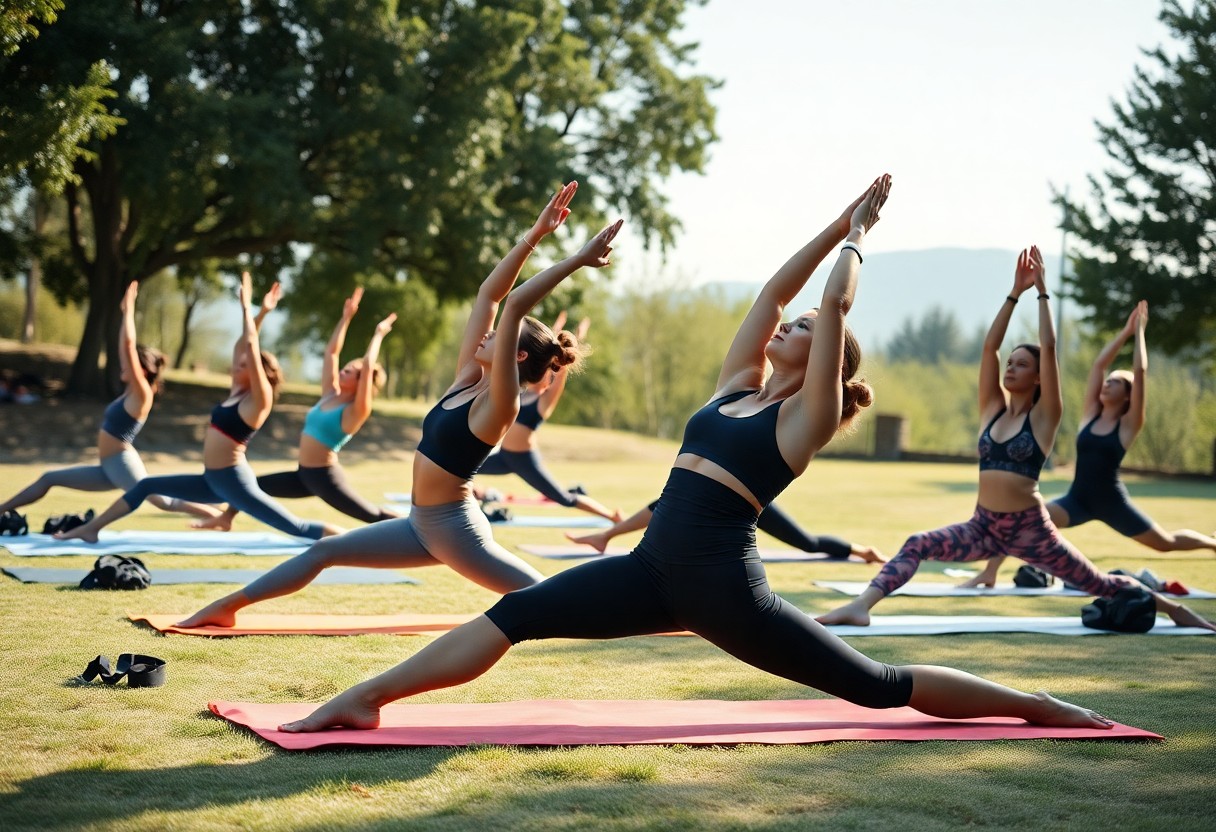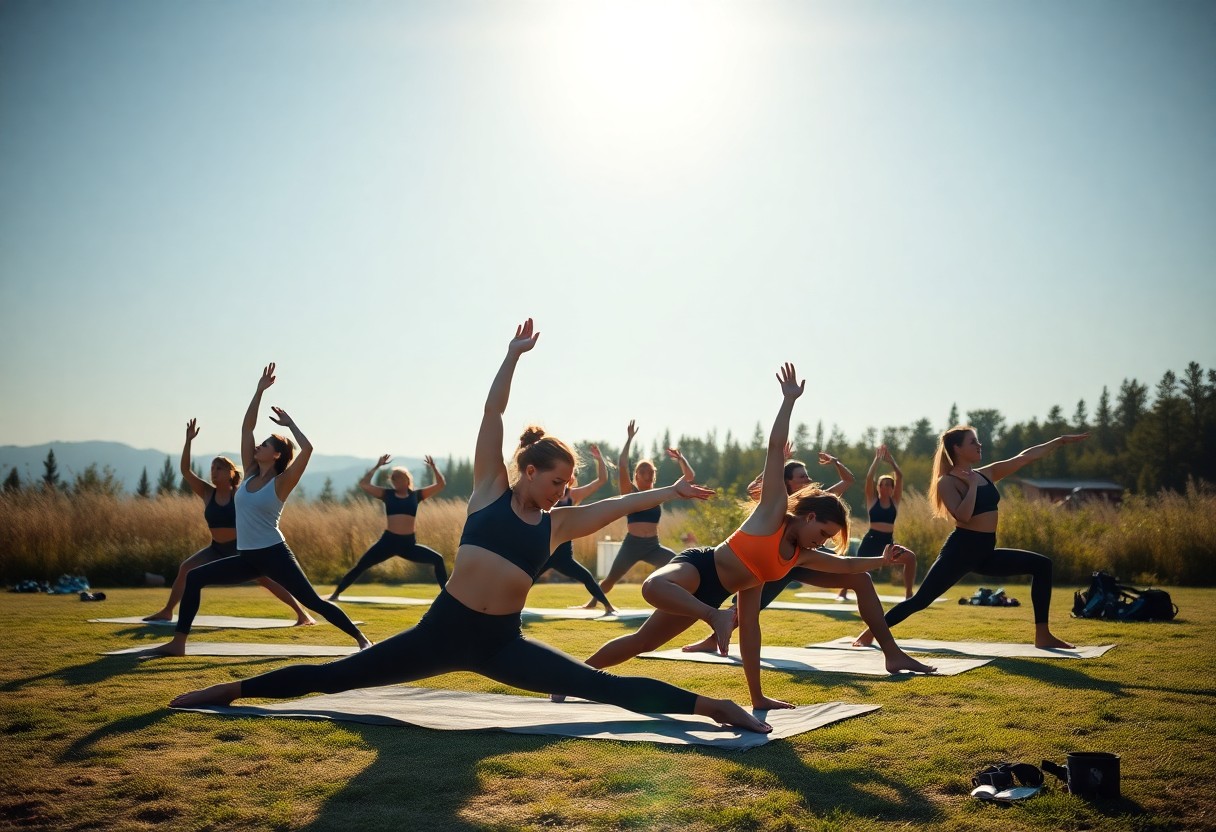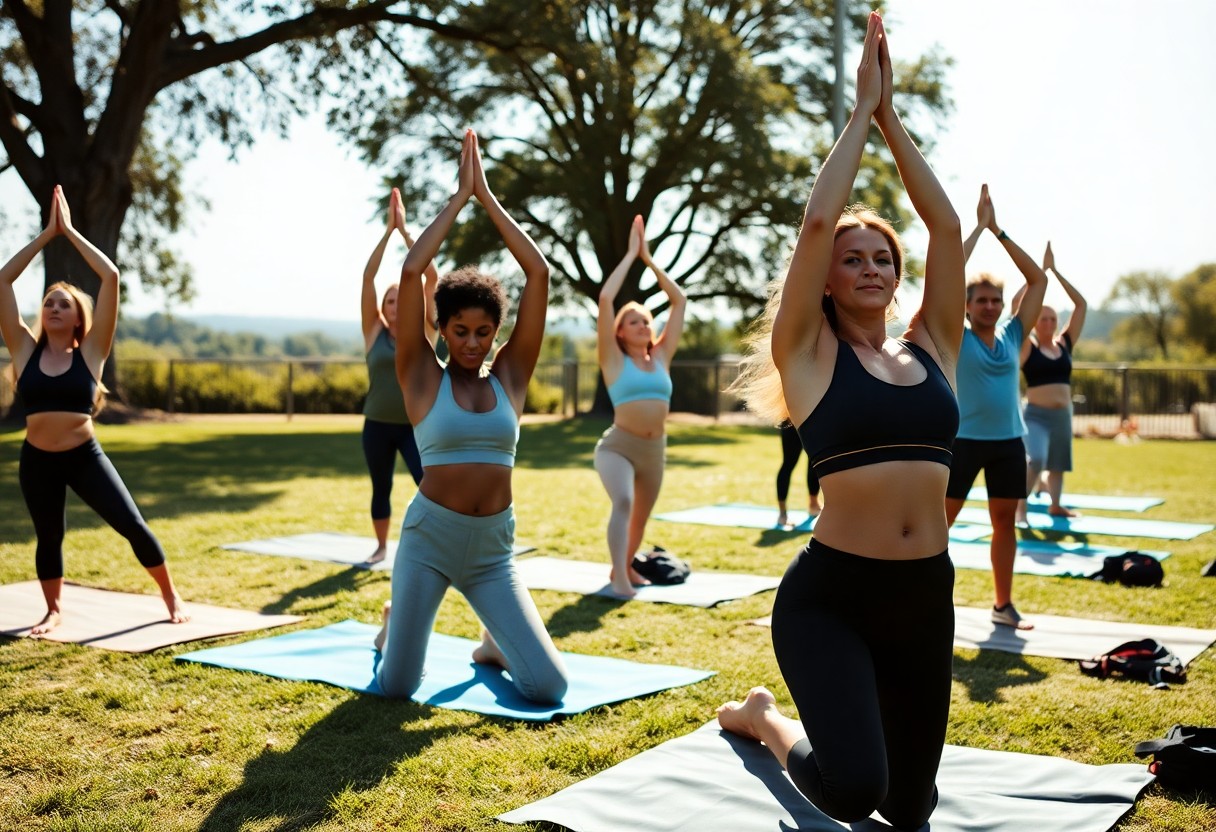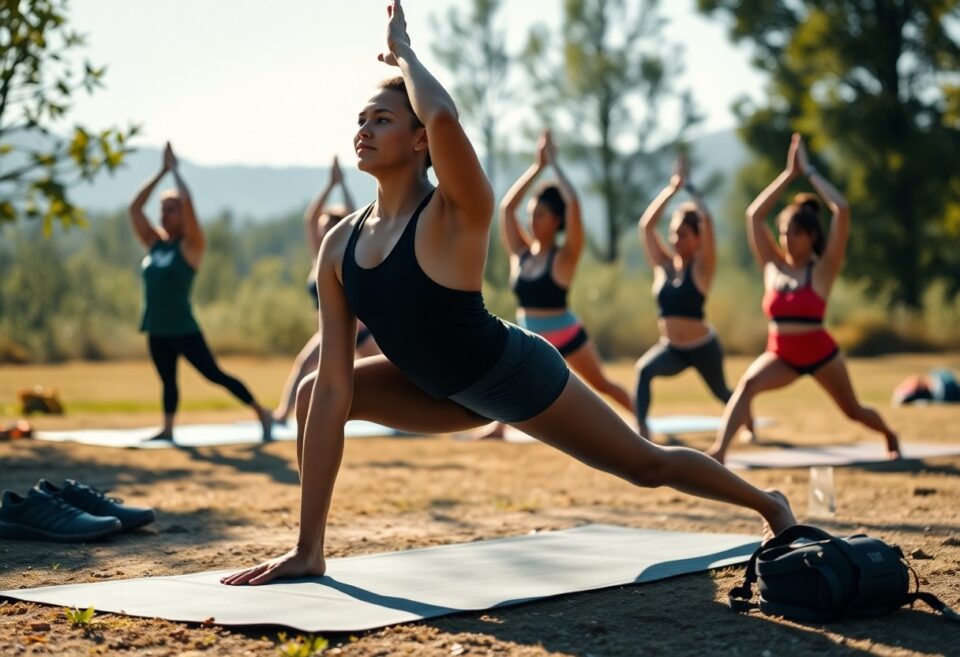Most athletes focus on strength and endurance, but integrating yoga into your routine can significantly enhance flexibility and reduce injury risks. By practicing yoga, you not only improve your muscle recovery but also increase mental clarity and focus, which are vital for peak performance. In this guide, you’ll discover how yoga complements athletic training, helping you unlock new levels of power and resilience while supporting your body’s natural healing processes.

Unleashing the Power of Breath: The Foundation of Performance
Breath acts as a direct bridge between your body and mind, making it a potent tool for athletes aiming to elevate performance. You might notice during an intense sprint or heavy lift, your breathing pattern changes — this shift directly influences your muscular endurance and mental focus. By mastering the mechanics of breath, you allow more oxygen to fuel your muscles, reduce fatigue, and accelerate recovery. Tracking your breath rate can also help you detect subtle signs of overtraining before they escalate into injury, giving you control over your body’s thresholds.
The connection between breathing and the autonomic nervous system is profound, meaning that how you inhale and exhale affects your heart rate, blood pressure, and stress hormones. When you use intentional, controlled breathing techniques, you can shift your physiological state from stress to relaxation. This shift benefits your nervous system by lowering cortisol levels, which in turn helps your muscles recover faster after a strenuous workout. It also improves cardiovascular efficiency and promotes better sleep quality—all vital factors for any athlete looking to sustain high-level training over time.
Expanding your breath capacity enhances lung function, which translates into a greater oxygen supply delivered to muscles during exertion. Studies reveal that athletes who integrate breath control exercises into their routines improve VO2 max — the maximum amount of oxygen your body can utilize during intense exercise. Even just a few minutes of diaphragmatic breathing daily can build lung elasticity, allowing you to maintain power output longer and recover quicker between bouts of intense activity.
The Neurological Benefits of Controlled Breathing
The nervous system reacts almost instantly to the way you breathe, with controlled breathing influencing the balance between your sympathetic (fight-or-flight) and parasympathetic (rest-and-digest) systems. When you practice slow, deep breaths, you activate the vagus nerve, which sends calming signals to the brain and body. This activation reduces neural excitability and dampens the effects of adrenaline during high-pressure moments. Consequently, you experience greater focus and reduced anxiety, enabling you to perform under stress more effectively.
Functional MRI studies highlight that controlled breathing not only impacts physical states but also modifies brain regions associated with emotional regulation and attention. You unconsciously enhance your prefrontal cortex activity—this area governs decision-making and executive control. For an athlete, this means heightened awareness and improved reaction times, allowing you to maintain strategic clarity even when fatigue sets in. Integrating breathwork into your training can thus create a neurological resilience that supports both mental and physical endurance.
Moreover, you can regulate pain perception through breath control due to the neurological pathways involved. Slow, rhythmic breathing has been shown to stimulate endorphin release and reduce the brain’s pain sensitivity. This effect allows you to push through discomfort during training or competition without triggering a stress response that could compromise performance. Over time, such neurophysiological conditioning helps increase your pain threshold, turning breath control into a natural form of analgesia that supports recovery and peak output.
Techniques for Maximizing Oxygen Intake
Optimizing oxygen intake starts by engaging your diaphragm rather than relying solely on shallow, chest-based breathing. Diaphragmatic breathing involves drawing air deep into the lungs, expanding the lower rib cage and belly. You may notice this method increases tidal volume, the amount of air you breathe per cycle, which in turn raises oxygen availability at the cellular level. Emphasizing exhalation as much as inhalation completes the respiratory cycle efficiently, preventing stale air accumulation and allowing fresh air to flow freely with each breath.
Incorporating rhythmic breathing patterns during exercise can further improve oxygen efficiency. For example, many endurance athletes adopt a 2:2 or 3:3 inhalation-to-exhalation ratio, timing breaths to their stride or pedal cadence. This technique not only synchronizes your breath with movement but also stabilizes intra-abdominal pressure, aiding core activation and reducing energy wastage. Scientific evidence shows that athletes using this method experience improved stamina and reduced instances of side stitches or cramping.
Apart from diaphragmatic and rhythmic breathing, alternate nostril breathing (Nadi Shodhana) offers promising benefits for oxygen balance and nervous system calm. This yogic practice involves consciously breathing through one nostril at a time while blocking the other, promoting even airflow and clearing nasal passages. Research finds that alternate nostril breathing can enhance oxygen saturation by up to 5%, support cardiovascular health, and reduce oxidative stress markers, all contributing to heightened recovery rates and performance consistency.
Delving further into techniques for maximizing oxygen intake, you might consider combining breath-holding exercises such as box breathing or the Wim Hof Method after breath activation practices. These methods temporarily raise carbon dioxide tolerance and strengthen your respiratory muscles, encouraging more efficient oxygen transfer in tissues during exertion. Ensuring you maintain proper posture throughout breathing exercises also maximizes lung expansion, making every breath count during your athletic endeavors.
Flexibility as a Competitive Advantage: Beyond Traditional Stretching
Rather than relying solely on static stretches performed before or after training sessions, integrating yoga into your regimen can dramatically enhance the quality and sustainability of your flexibility gains. Unlike conventional stretching that typically targets isolated muscles, yoga emphasizes whole-body movements that engage multiple muscle groups and connective tissues simultaneously. This comprehensive engagement promotes a more balanced, functional flexibility that supports dynamic athletic movements and reduces injury risk. Moreover, yoga’s controlled, mindful breath work ensures muscles remain relaxed yet fully engaged, fostering deeper elongation without triggering defensive muscle tightening that can occur during forced stretching.
The enhancement of flexibility through yoga also translates into improved proprioception—your body’s ability to perceive its position in space—which is often overlooked in standard stretching routines. This heightened body awareness allows you to better control joint alignment and movement patterns across a variety of athletic endeavors. Over time, you’ll notice enhanced joint mobility that supports greater power transfer and efficiency in your sport, whether it be the explosive demands of sprinting, the rotational torque of golf, or the extended reach needed in swimming. By cultivating flexibility with mindful precision and neuromuscular control, you gain a competitive edge that goes far beyond mere range of motion.
Adopting yoga as your primary flexibility practice also helps mitigate overuse imbalances common among athletes. For example, runners frequently experience tight hip flexors and hamstrings, creating a risk for lower back and knee injuries. Yoga sequences tailored to open these areas not only lengthen muscles but also strengthen supporting stabilizers, creating a more resilient kinetic chain. This balance between flexibility and muscular control prevents deterioration in movement quality as fatigue sets in during training or competition. In practice, this means your flexibility isn’t just a temporary advantage but an integral part of your consistent, high-level athletic performance.
The Physiology Behind Increased Range of Motion
Your joints’ capacity for movement depends not only on muscle length but also on the extensibility of tendons, ligaments, and the surrounding connective tissues such as fascia. Yoga applies gentle sustained tension to these structures, stimulating their remodeling and increasing their pliability over time. This process, known as mechanotransduction, prompts cells within connective tissue to synthesize new collagen fibers aligned according to the stresses applied, effectively adapting the tissue to your sport-specific demands. The slow, controlled movements typical of yoga are ideal for harnessing this biological response without risking microtears or inflammation.
The nervous system plays a pivotal role in limiting or enhancing your flexibility. Muscle spindle fibers detect stretch and signal your muscles to contract to prevent injury—a protective reflex known as the stretch reflex. Repetitive yoga practice helps modulate this response by training your nervous system to tolerate greater stretch without triggering defensive contraction. Simultaneously, activation of the Golgi tendon organs during sustained poses inhibits muscle tension, allowing deeper, safer elongation. This neurophysiological interplay means that over weeks and months, your range of motion increases not only through physical changes but also through improved neural tolerance for stretch.
At a cellular level, consistent yoga practice enhances blood flow and nutrient delivery to musculoskeletal tissues, optimizing their metabolism and recovery capacity. Increased circulation reduces the accumulation of metabolic waste products that can stiffen muscles and joint capsules. Furthermore, your body’s anti-inflammatory responses are amplified, assisting in healing minor microtraumas that naturally arise from intense training. This improved tissue health supports sustained flexibility gains and aids in minimizing soreness or stiffness that might otherwise compromise performance and recovery after workouts.
Essential Yoga Poses for Different Sports
For athletes aiming to tailor flexibility training to their specific sport, certain yoga poses stand out due to their ability to target critical muscle groups and joint ranges. Runners, for example, benefit from poses like the Pigeon Pose (Eka Pada Rajakapotasana), which deeply stretches the hip flexors and glutes—areas frequently tight from repetitive forward motion. Similarly, Swimmers gain from Downward Dog (Adho Mukha Svanasana) and Thread the Needle, which open shoulders and thoracic spine, enhancing stroke capability. Meanwhile, athletes in explosive sports such as basketball or soccer find Chair Pose (Utkatasana) and Warrior II (Virabhadrasana II) imperative for building both flexibility and strength in the lower body, enabling powerful jumps and rapid directional changes.
Incorporating these poses into your routine can complement your existing sport-specific drills and conditioning work. Precise alignment cues and breath synchronization while holding these postures help activate stabilizing muscles often neglected in traditional training. This holistic approach improves joint stability alongside flexibility, reducing injury risk from sudden dynamic loads. Progressively deepening your practice with variations or longer holds further encourages connective tissue adaptation and neuromuscular control, critical for enduring peak performance throughout your competitive season.
Additionally, these foundational poses serve as a gateway to more advanced sequences that challenge multi-planar movements and balance, which are common in most sports. For example, transitioning from Warrior II into Revolved Triangle Pose (Parivrtta Trikonasana) enhances spinal rotation and hip mobility, beneficial for tennis players and martial artists who rely heavily on torque generation. Adopting a sport-specific yoga routine empowers you to customize your flexibility training, aligning it directly with the biomechanical demands you face and ensuring the greatest carryover into your athletic performance.
Understanding how to select and adapt yoga poses to your sport’s unique requirements ensures that your flexibility routine is not just generalized stretching but a strategic tool that enhances your functional movement, injury resilience, and overall athletic longevity. This targeted focus on sport-specific flexibility through yoga makes your training smarter and your competitive edge sharper.
Mastering Focus: The Psychological Benefits of Yoga
Mindfulness and Its Impact on Athletic Performance
Mindfulness through yoga practice serves as a powerful tool to sharpen your awareness both on and off the field. By tuning into the present moment, you reduce the mind’s tendency to wander, which directly improves your ability to maintain concentration during high-pressure situations in sports. Research shows that athletes who incorporate mindfulness training into their routines report significant reductions in performance anxiety and increased confidence, translating into more consistent results during competition.
Practicing sustained attention during yoga poses trains your brain to resist distractions, allowing for improved decision-making and strategic thinking during fast-paced gameplay. For example, distance runners who engage in mindfulness meditation alongside their physical training often report an enhanced ability to monitor bodily sensations, helping manage pain and fatigue more effectively throughout races. This heightened bodily awareness prevents overexertion and fosters smarter pacing strategies.
Notably, mindfulness sharpens your emotional regulation by helping recognize and calm negative thoughts or stress that might otherwise throw off your focus. In contact sports like football or basketball, this improved emotional control keeps you composed after setbacks such as missed shots or injuries, making your overall mental game stronger. The cumulative effect is a foundation of resilience, concentration, and emotional steadiness that elevates every aspect of athletic performance.
Techniques for Enhancing Mental Resilience
Cultivating mental resilience begins with integrating specific yogic techniques such as pranayama (breath control) and dharana (focused concentration). Controlled breathing exercises promote a reduction in cortisol levels, which reflects your body’s stress state, enabling you to stay calm during moments of intense competition. Holding your breath steady during complex asanas builds a meditative focus that directly trains your mind to maintain poise and clarity when confronted with unpredictable challenges in sport.
Visualization techniques practiced during savasana or seated meditation deepen your mental stamina by simulating high-pressure scenarios, allowing you to mentally rehearse responses and problem-solving strategies. These rehearsals activate neural pathways associated with motor skills and emotional regulation, effectively conditioning your brain to respond with greater agility under competition stress. Elite athletes often credit such visualization practices for improving clutch performance in critical moments.
Embedding consistent yoga sessions into your weekly routine fosters an enduring mindset that embraces obstacles as growth opportunities, strengthening your perseverance through setbacks. Each session compounds the effect by reinforcing a positive feedback loop of self-awareness and self-regulation, ensuring that you bounce back faster from errors and maintain motivation over long training cycles or competitive seasons.
Additional resources exploring techniques for mental resilience include guided pranayama practices tailored for athletes, which focus on breath rhythm synchronization to optimize oxygen flow and stress response. Comprehensive mindfulness workshops integrate these concepts with sport-specific visualization drills, providing an immersive approach to building the mental fortitude necessary for peak athletic performance.

Recovery Revolution: How Yoga Accelerates Healing
The Role of Yoga in Muscle Recovery and Repair
After intense training or competition, your muscles undergo microscopic tears that initiate the repair process, which is fundamental for strength gains and performance enhancement. Yoga supports this process by improving blood circulation, delivering oxygen and necessary nutrients to damaged tissues more effectively. Several studies have shown that gentle yoga movements promote lymphatic drainage, flushing out metabolic waste products like lactic acid, which are often responsible for post-exercise soreness. This enhanced circulation accelerates your muscle’s natural recovery timeline, allowing you to bounce back faster for subsequent workouts.
Integrating yoga into your post-exercise routine helps reduce muscle inflammation, a key factor that can delay recovery when left untreated. Poses that involve dynamic stretching and controlled breathing stimulate the parasympathetic nervous system, which eases tension and reduces cortisol levels. Lower cortisol not only mitigates inflammation but also fosters a better hormonal balance for tissue repair. Athletes engaging in regular yoga have reported notable decreases in delayed onset muscle soreness (DOMS), enabling them to maintain high training volumes with less downtime.
The type of yoga you practice matters when focusing on muscle recovery. Restorative and yin yoga styles, with prolonged holds and minimal muscular effort, encourage the lengthening of fascia and improvement in joint mobility without adding strain. This helps muscles regain their elasticity and prevents stiffness, which otherwise could compromise your technique or increase injury risk. You’ll often find that after a yoga recovery session, your range of motion feels more fluid and your muscles less tense, giving you a competitive edge by staying both strong and supple.
Incorporating Restorative Practices into Training
Introducing restorative yoga into your training regimen offers more than just physical benefits; it actively enhances your nervous system’s recovery. By dedicating even 20 to 30 minutes post-training or on rest days to gentle yoga, you target the release of neuromuscular tension accumulated during strenuous workouts. This deliberate slowdown balances your sympathetic and parasympathetic activity, necessary for reducing mental and physical fatigue levels. Many elite athletes have adopted practices such as supported bridge poses and prolonged child’s pose to activate this recovery mechanism, improving overall training sustainability over a season.
Scheduling your restorative sessions requires attention to your weekly load and fatigue markers. Integrating gentle yoga after high-intensity training days optimizes recovery windows without compromising muscle adaptations. For example, sequencing a slow-flow yoga session that emphasizes breath control and spinal alignment after a heavy lifting day can significantly reduce stiffness and boost joint lubrication. This practice also complements other recovery modalities like massage or hydrotherapy, creating a multifaceted approach to healing that addresses both muscular and connective tissue repair.
The psychological relaxation achieved during restorative yoga plays a profound role in maintaining training consistency. As athletes, accumulated stress can manifest as disrupted sleep or elevated anxiety, undermining recovery and performance. Employing yoga techniques such as alternate nostril breathing or guided meditation during sessions aids your parasympathetic rebound, enhancing sleep quality and reducing cortisol spikes. The synergy between mind and body recovery you cultivate through restorative yoga promotes a holistic healing environment, which is often the differentiating factor in long-term athletic development.
For deeper integration, you might consider combining restorative yoga sessions with mobility drills tailored to your sport’s specific demands. This targeted approach not only expedites recovery but also addresses movement pattern imbalances that could hinder performance or predispose you to injury. By aligning restorative practices with your training objectives, you create a sustainable cycle of recovery and readiness that propels your athletic progress forward.

Crafting a Personalized Yoga Routine for Your Sport
Assessing Your Unique Needs as an Athlete
Start by evaluating the specific physical demands and common injury patterns associated with your athletic discipline. If you are a runner, for example, you might experience tight hamstrings and hip flexors, making poses that lengthen these areas—such as Hanumanasana (Splits Pose) or Reclined Pigeon—particularly beneficial. Conversely, if you are a swimmer, your shoulders endure repeated stress, so incorporating poses like Bharadvajasana (Seated Spinal Twist) and Gomukhasana (Cow Face Pose) can support shoulder mobility and stability. Understanding these sport-specific tight spots allows you to prioritize postures that create balance and reduce overuse risk.
Your current physical condition and any existing injuries should also inform your routine. For example, athletes with a history of knee issues might focus on strengthening the muscles around the joint through poses like Virabhadrasana II (Warrior II) while avoiding deep twists that could exacerbate discomfort. Including a movement screening or even consulting with a physical therapist experienced in sports medicine can provide valuable insights about muscular imbalances or mobility restrictions. Yoga becomes most effective when it targets these precise weak links rather than relying on a generic sequence.
Finally, consider your training schedule intensity and recovery needs. On heavy training days, lighter, restorative practices such as Supta Baddha Konasana (Reclined Bound Angle Pose) or Viparita Karani (Legs-Up-The-Wall Pose) facilitate parasympathetic nervous system activation, which can accelerate healing and reduce cortisol levels. On off days, more dynamic flows integrating strength and flexibility—like Vinyasa sequences with poses such as Chaturanga Dandasana (Four-Limbed Staff Pose)—can maintain conditioning without adding undue fatigue. Your bespoke routine should evolve alongside your training cycles to maximize synergy.
Sample Routines Tailored for Different Athletic Disciplines
A deep probe sport-specific yoga sequences reveals a range of tailored options proven effective across disciplines. For endurance athletes like marathoners, routines emphasizing lower-body pliability and core stability—through poses such as Utthita Trikonasana (Extended Triangle Pose) and Phalakasana (Plank Pose)—improve stride efficiency and reduce fatigue-related injuries. In contrast, power athletes including football players benefit from yoga flows that enhance hip mobility and shoulder stabilization, incorporating poses like Malasana (Garland Pose) and Adho Mukha Vrksasana (Handstand) progressions to boost explosive movement capacity.
Yoga for cyclists often prioritizes deep opening of the hip flexors and relief of lower back tension. Poses such as Anjaneyasana (Low Lunge) and Supta Padangusthasana (Reclining Hand-to-Big-Toe Pose) address these areas, helping maintain efficient pedaling mechanics. Meanwhile, dancers or gymnasts might integrate more advanced balance and inversions—like Ardha Chandrasana (Half Moon Pose) and Salamba Sirsasana (Supported Headstand)—to enhance proprioception and body control. Each routine not only targets physical performance but also attends to mental sharpness through breath awareness and concentration techniques unique to yoga.
Implementing these tailored routines can lead to remarkable improvements. Research involving collegiate athletes found that a six-week yoga regimen customized by sport reduced injury rates by 35% and improved vertical jump power by 12%. Such findings underscore the importance of systematic adaptation rather than adopting one-size-fits-all yoga sequences. Experimenting with and refining these examples, while tuning into your body’s feedback, will allow you to harness yoga as a strategic tool for athletic excellence.
For those eager to translate these concepts into practice, further resources exist—including guided video classes and workshops designed for specific sports—to streamline routine development. Working with a yoga instructor who understands the nuances of your athletic requirements can accelerate progress and ensure each session aligns with your performance goals.
Conclusion
So, integrating yoga into your athletic routine can significantly enhance your performance and aid in recovery. By developing greater flexibility, balance, and strength through focused yoga practices, you equip your body to move more efficiently and avoid injuries. This mindful approach to movement allows you to tap into your full potential and maintain peak physical condition, ultimately leading to better results in your sporting endeavors.
Moreover, yoga offers much more than just physical benefits; it cultivates mental resilience and sharpens your concentration. As an athlete, managing stress and maintaining a calm, focused mindset during competition can be as important as physical preparedness. Yoga techniques such as controlled breathing and meditation can help regulate anxiety, improve your mental clarity, and boost your confidence, which translates into improved performance under pressure.
In addition to enhancing your training and competition readiness, yoga supports your recovery process by promoting circulation, reducing muscle soreness, and encouraging relaxation. Incorporating restorative yoga sessions after intense workouts can decrease fatigue and speed up healing, enabling you to train consistently without burnout. Ultimately, by embracing yoga, you create a holistic approach to your athletic development that nurtures both body and mind, positioning you for sustained success in your sport.
FAQ
Q: How can yoga improve athletic performance?
A: Yoga enhances athletic performance by increasing flexibility, balance, and strength. It also improves breath control and mental focus, which can boost endurance and precision in various sports activities.
Q: What types of yoga are most beneficial for athletes?
A: Styles such as Vinyasa, Hatha, and Yin yoga are particularly advantageous for athletes. Vinyasa promotes strength and cardiovascular health, Hatha focuses on alignment and flexibility, and Yin helps with deep muscle and connective tissue recovery.
Q: How often should athletes practice yoga to see benefits?
A: Practicing yoga two to three times a week is generally effective for athletes to notice improvements in mobility, mental clarity, and injury prevention. Consistency is key to gaining the full advantages of yoga.
Q: Can yoga help with injury prevention for athletes?
A: Yes, yoga supports injury prevention by enhancing joint stability, improving muscle balance, and increasing overall body awareness. These factors help reduce the risk of strains, sprains, and overuse injuries.
Q: How does yoga aid in recovery after intense workouts or competitions?
A: Yoga promotes recovery by facilitating muscle relaxation, reducing tension, and encouraging better circulation. Gentle stretching and breathing exercises help alleviate soreness and accelerate the healing process.
Q: Is yoga suitable for all types of athletes regardless of their sport?
A: Yoga is adaptable and can benefit athletes across a wide range of sports. While specific poses can be tailored to address the demands of different disciplines, the overall improvements in flexibility, strength, and mental focus are universal.
Q: What role does breathing play in yoga for athletes?
A: Breathing techniques in yoga improve oxygen intake and promote better control over the nervous system. This leads to enhanced endurance, reduced stress, and quicker recovery times, all of which support athletic performance.
